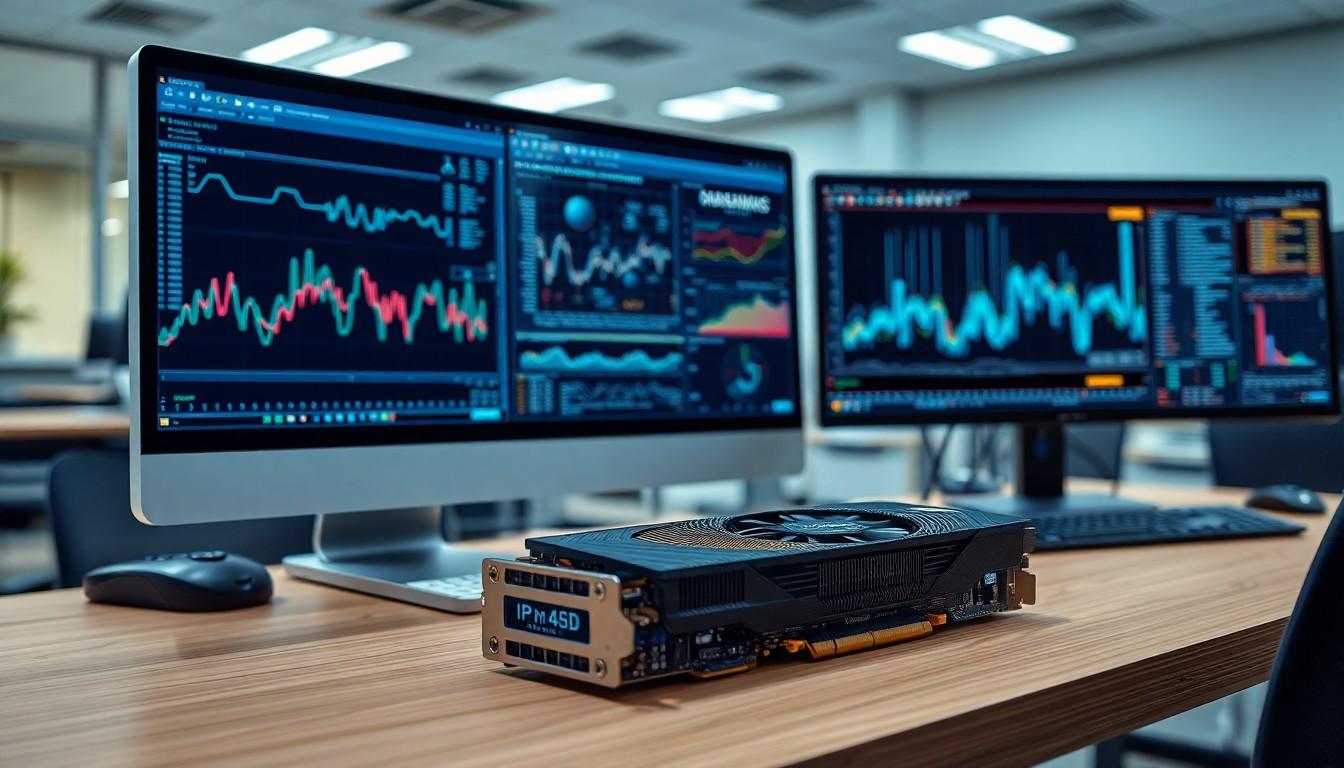Table of Contents
ToggleIn the ever-evolving world of artificial intelligence, the question of what GPU powers ChatGPT can spark curiosity faster than a cat chasing a laser pointer. This powerhouse model relies on cutting-edge technology to deliver responses that are not just smart but also surprisingly witty. If you’ve ever wondered what kind of digital muscle fuels those clever replies, you’re in for a treat.
Overview of ChatGPT
ChatGPT operates on advanced machine learning models designed for natural language processing. It excels in generating human-like text based on input prompts, delivering responses with contextual relevance. The underlying architecture relies on the transformer model, enabling it to process vast amounts of data effectively.
GPUs play a crucial role in powering these models. They facilitate parallel processing, allowing for rapid computations necessary for training and running neural networks. High-performance GPUs, such as NVIDIA A100 and V100, frequently support ChatGPT’s functions. These models increase throughput, enhancing the responsiveness of ChatGPT during interactions.
In terms of scale, ChatGPT incorporates numerous parameters, often reaching billions, to capture nuanced language patterns. This complexity demands substantial computational resources. Each deployment of ChatGPT leverages multiple GPUs to manage processing loads efficiently. Such an approach ensures that interactions remain smooth and immediate for users.
By utilizing cloud infrastructure, developers can dynamically allocate GPU resources based on demand. This flexibility optimizes performance and reduces latency across various applications. Consequently, ChatGPT can serve many users simultaneously while maintaining response quality.
Continuous advancements in GPU technology contribute to the model’s capabilities. Ongoing developments in hardware and optimization techniques allow ChatGPT to evolve, pushing the limits of conversational AI. Ultimately, the integration of cutting-edge GPUs ensures that ChatGPT remains at the forefront of natural language processing technology.
Importance of GPUs in AI

GPUs play a vital role in artificial intelligence, particularly in training complex models like ChatGPT. By processing large datasets quickly, they enable efficient computations needed for deep learning.
Role of GPUs in Machine Learning
GPUs accelerate machine learning tasks by executing multiple parallel operations. This parallelism allows them to handle vast amounts of data rapidly, essential for model training. Training a model like ChatGPT involves processing billions of parameters, which requires immense computational power. That’s where GPUs shine, reducing training time from weeks to days. Increased efficiency helps data scientists push boundaries in natural language processing, resulting in more accurate and responsive AI systems.
Difference Between CPUs and GPUs
CPUs excel at handling individual threads and general-purpose tasks, while GPUs are designed for highly parallel workloads. Optimized for graphics rendering, GPUs can simultaneously process thousands of threads. This architecture makes GPUs significantly faster for tasks involving matrix multiplications and large-scale data analysis. A typical CPU has a few cores, whereas modern GPUs may contain thousands. Their specialized nature allows GPUs to outperform CPUs in tasks that require intensive numerical computations, making them indispensable in AI development.
What GPU Does ChatGPT Use?
ChatGPT leverages high-performance GPUs to deliver its advanced capabilities. The primary GPUs utilized are NVIDIA A100 and V100 models, known for their exceptional computational power.
Detailed Specifications
The NVIDIA A100 GPU features a memory capacity of 40GB to 80GB and a peak performance of 20 teraflops in single precision tasks. In contrast, the V100 GPU offers 16GB to 32GB of memory with a performance ceiling of 7.8 teraflops. Both GPUs utilize Tensor Core technology, optimizing matrix operations crucial for neural network training. These specifications enable ChatGPT to handle extensive datasets effectively, ensuring efficient processing during model training and inference.
Performance Analysis
Performance measures indicate the significant advantages of using A100 and V100 GPUs. Specifically, A100 GPUs enhance throughput, allowing multiple processing tasks simultaneously. Training complex models on these GPUs reduces the time from weeks to days, demonstrating substantial efficiency gains. Additionally, the architecture of the GPUs ensures that ChatGPT maintains responsiveness during user interactions. Performance metrics further illustrate that using multiple GPUs not only balances the load but also enhances overall response time, providing users with seamless experiences.
Impact of GPU on ChatGPT’s Efficiency
Efficiency in ChatGPT stems from its reliance on high-performance GPUs, particularly the NVIDIA A100 and V100. These models feature advanced technology that accelerates computations essential for deep learning and natural language processing. With a memory capacity reaching 80GB in the A100 and the V100 offering up to 32GB, these GPUs accommodate extensive datasets with ease.
Parallel operations are a significant advantage of GPUs, enabling them to execute numerous tasks simultaneously. This capability dramatically reduces training times. For instance, complex model training that typically spans weeks can be completed in mere days. Accelerated training translates to faster updates and improvements in ChatGPT’s responsiveness.
NVIDIA’s Tensor Core technology enhances performance by optimizing matrix operations. Such optimizations directly benefit neural network training, allowing ChatGPT to understand and generate human-like text quickly. Enhanced throughput from the A100 model further allows it to manage multiple requests without sacrificing speed.
Smooth interactions are crucial for user experience. Each instance of ChatGPT deployment incorporates several GPUs, balancing workloads efficiently to maintain low latency. Dynamic allocation of GPU resources in the cloud infrastructure ensures that demand spikes do not hinder performance.
Advancements in GPU technology continue to push the boundaries of what’s possible in AI. As newer models emerge, they promise even more computational power. Such improvements not only bolster ChatGPT’s efficiency but also fortify its position at the forefront of natural language processing. Each enhancement adds depth to its understanding of language patterns, ultimately enriching user interactions.
Future of GPUs in AI Models
Future advancements in GPUs are likely to significantly impact AI models, including those like ChatGPT. Increased computational power enables models to process larger datasets and learn more complex patterns in human language. Continuous improvements in architectures, such as NVIDIA’s Hopper and Grace, focus on enhanced efficiency and performance, catering specifically to AI workloads.
Faster memory interfaces and greater bandwidth can provide the necessary support for real-time processing. Newly designed GPUs promise efficiency gains that translate to quicker training times. Enhanced parallel processing capabilities allow multiple tasks to run simultaneously, benefiting models that demand rapid data analysis.
Emerging technologies, such as quantum computing, might further redefine AI capabilities. This could lead to a new era of performance where GPU architectures integrate seamlessly with quantum processors, unlocking unprecedented efficiency. Increased energy efficiency will also be crucial, minimizing environmental impact while maximizing output.
Developers can expect GPUs to become more specialized for AI tasks, optimizing them for both training and inference. The integration of AI-specific processing units, like Google’s TPU, highlights the trend toward tailored hardware solutions. These developments ensure that AI models can achieve and maintain responsiveness, a vital characteristic for user interaction.
As machine learning techniques evolve, supporting hardware must adapt accordingly. Innovations in multi-GPU setups will enhance workload distribution and load balancing, improving the model’s ability to scale efficiently. Anticipated enhancements in software frameworks will further enable GPUs to perform optimally, ensuring that future AI systems remain at the cutting edge of technology.
Understanding the GPUs that power ChatGPT reveals the intricate technology behind its impressive capabilities. The NVIDIA A100 and V100 models play a crucial role in enabling rapid computations and efficient processing of complex language patterns. Their advanced specifications and parallel processing abilities ensure that ChatGPT can generate human-like responses in real time.
As GPU technology continues to evolve, the future promises even greater advancements that will enhance the performance and scalability of AI models. This ongoing innovation will likely lead to more sophisticated interactions and improved user experiences, solidifying ChatGPT’s position at the forefront of natural language processing. With each technological leap, the potential for AI applications expands, paving the way for exciting developments in the field.




